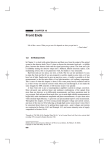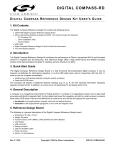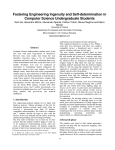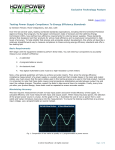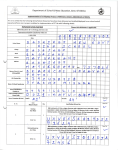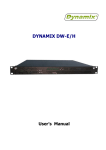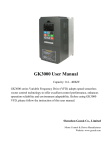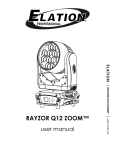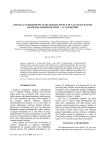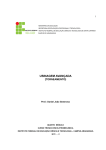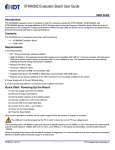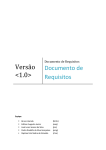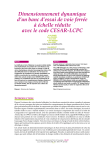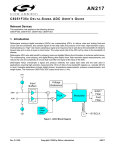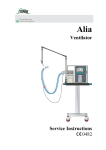Download world band radio receiver with analog control and led display
Transcript
U.P.B. Sci. Bull., Series C, Vol. 77, Iss. 4, 2015 ISSN 2286-3540 WORLD BAND RADIO RECEIVER WITH ANALOG CONTROL AND LED DISPLAY Laurenţiu TEODORESCU1, Andrei-Sorin GHEORGHE2 This work focuses on the design of a digital world band radio receiver. The system control functions are handled by an 8-bit microcontroller with an internal analog to digital converter (ADC). The unit uses a 7-segment light emitting diodes (LED) display to allow the information to be visible from a distance, and a local keyboard for programming its functions. All keyboard buttons are connected to the ADC inputs. The tuning operation is analog, by using a rotary potentiometer. Keywords: receiver, ADC, 7-segment LED display, I2C bus, digital radio, analog control, 8-bit microcontroller, interrupt 1. Introduction Today we are celebrating more than 60 years since the first commercially manufactured transistor radio was sold [1]. Since then, outstanding technical advances have resulted in increased performance and a reduced size of the receivers. The last achievement of the semiconductor industry in the audio field is the development of some digital Complementary Metal-Oxide-Semiconductor (CMOS) Integrated Circuits (IC’s) [2] intended to be used as a complete solution for the radiofrequency (RF) section inside an amplitude modulation (AM) / frequency modulation (FM) radio receiver. These ICs have both low power consumption and high performance, making them the right choice for a competitive digital receiver. The purpose of this paper is to present the design technique of a modern receiver using CMOS technology. The unit is made up of an analog-tuned digital CMOS AM/FM/SW IC [3] that integrates the complete digital receiver function, from the antenna input connector to the audio output jack. This IC is controlled on a serial bus by a programmable analog intensive 8-bit microcontroller [4]. A 7segment LED display allows the information to be clearly visible at night or during storms, at large distances (1-5m) from the receiver. The keyboard and the tuning circuits are connected through a few analog interfaces to the 8-bit microcontroller. Some special techniques are applied to obtain a minimum 1 Ph.D., Dept. of Devices, Circuits and Electronic Architectures, University POLITEHNICA of Bucharest, Romania, e-mail: [email protected] 2 Eng., Infineon Technologies Romania SCS, e-mail: [email protected] 246 Laurenţiu Teodorescu, Andrei Sorin Gheorghe number of external components. The adjustment procedures are missing since there are no tuning coils or trimmer capacitors. The power consumption is small, allowing the system to be supplied from only 2 IEC LR6 [5] batteries. 2. The receiver block diagram The block diagram of the receiver is shown in Fig. 1. The system consists of an RF input stage (Lin, C1, FM Coil, AM coil, SW RF amplifier), a CMOS receiver integrated circuit (Silicon Laboratories SI4844-B [3]), an ultralow voltage stereo audio power amplifier (Texas Instruments TPA6100A2DR [6]), an 8-bit microcontroller with an integrated 24-bit ADC (Silicon Laboratories C8051F350[4]), a keyboard and a 7-segment LED display. ANTENNA Lin SW RF AMP C1 33p AM Coil FM Coil IRQ POT Audio Amplifier R TPA6100 ADC CPU R SPK D I S P L A Y Digital I/O Keyboard L SPK L SDA SCL RST SI4844-B CMOS IC Receiver Memory OSC C8051F350 uC S1 BATTERY 3V +3V Power ON/OFF CB 100u 4V Fig. 1. The block diagram of the radio receiver The electric power is supplied from batteries. A stick external antenna is connected for shortwave (SW) or frequency modulation (FM) reception. World band radio receiver with analog control and LED display 247 3. Principle of operation If the power switch (S1, Fig.1) is in the closed (ON) position, the supply voltage (3V) is applied to the microcontroller [4]. Then, the unit peripherals are initialized: the display is turned on and the analog to digital converter (ADC) monitors the local keyboard status. The receiver IC [3] is automatically put in off state, waiting for external commands. The microcontroller acts as the master device on the 4-wire data bus (Reset – RST, I2C clock – SCL, I2C data – SDA, interrupt – IRQ), and SI4844-B [3] (ATDD –Analog Tune Digital Display, [7]) is the slave device. Q 32KHz SS 4-digit 7-segment display C8051F350 Microcontroller DS R0 (Master) R1 R2 Rn+1 SW1 SW2 SWn IRQ SDA SCL RST SI4844-B ATDD (Slave) P TUNE Vref Fig. 2. The communication between the microcontroller and peripherals When the POWER ON key (SW1, Fig. 2) is pressed, the microcontroller[4] starts the communication with SI4844-B [3] (Fig. 1, 2) and it puts the receiver in on state: it turns on the 32KHz slave crystal oscillator, it selects the RF band type and its properties, and finally, it adjusts the volume or tone values. By default, the FM band is selected after the first power up. The band and the frequency information are sent periodically to the master device for updating them. The microcontroller [4] computes and then converts this information to be released to the 4-digit-7-segment display. The microcontroller and the display are connected through 8 wires (SS) which select the segments (7 wires for the digits, 1 wire for the dot) and through 4 wires which address the four digits. If the band key is pressed, the modified band type, followed by the corresponding frequency values, are displayed. The frequency is adjusted by changing the cursor position of the potentiometer (P). There are also some keys to increase or decrease the volume value or to simply mute the system. The same power key is used to power off the unit. In the off mode most of the slave internal blocks (including the oscillator) are stopped to save battery power. 248 Laurenţiu Teodorescu, Andrei Sorin Gheorghe 4. Hardware design The RF section block diagram is depicted in Fig.3. It contains a SI4844-B integrated circuit [3], an FM input circuit, an AM input circuit, a shortwave RF low noise amplifier and the FM/SW RX antenna. Fig. 3.The block diagram of the RF section[3] The IC [3] (Fig.3) contains a CMOS low noise amplifier (LNA). The LNA inputs are connected to an internal variable capacitor, which forms a tuned circuit with the external coils. The change of internal capacity is performed in steps, by switching of MOS transistors in series with small internal capacitors. LNA gain is automatically controlled by the AGC block. The internal precision oscillator (XTAL OSC) uses an external quartz crystal (Q). The signal from XTAL OSC is applied to an automatic frequency circuit (AFC) which monitors the high frequency sinusoidal oscillator. A double mixer block takes the signals from the LNA and from the high frequency oscillator. The resulted low intermediated frequency (low IF) signals are sent to analog to digital converters (ADC) blocks to be translated in digital format. A digital signal processor (DSP) controlled by the internal digital interface performs all audio signal adjustments. Two digital to analog converters (DAC) transform the digital audio signal in analog signal. An external potentiometer (P) connected to an ADC is used for tuning the high frequency oscillator. In this way, the desired radio station can be received by changing the frequency with the potentiometer. The FM input circuit [8](Fig. 4) is formed by a monopole antenna in λ/4 (whip stick antenna) and D1, Lin, C1, L3 elements. The antenna has variable length World band radio receiver with analog control and LED display 249 (18cm÷60cm). D1 is a high speed switching antiparallel diode pair with low internal capacitance (1.5pF) mounted for electrostatic discharge (ESD) protection. Lin is an inductor load to change the electrical length of the antenna. It compensates the short length of the stick antenna by keeping it in resonance with the FM bandwidth. ANTENNA C1 Lin 120nH 33p FMI SI4844-B L3 270nH Cin1 Q1 D1 Cin2 ... Q2 CinN ... QN BAV99 ... Control Circuit Fig. 4.The FM input circuit The output impedance of the antenna is[9]: · 36.5 · 21.5 Ω (1) The imaginary term from expression (1) is capacitive. The antenna output capacitance is between 20pF÷36pF in FM band (88÷108MHz) at its maximum length (60cm). The simplified equivalent circuit (Fig.5) of the stick antenna includes two resistors which model the radiation (Rr) and the dissipation (Rd) resistances. Rd ANT. IN ANT. OUT Rr Fig. 5.The antenna equivalent circuit The radiation resistance is defined by equation (2)[10]: 40 (2) In the equation (2), L represents the antenna variable length and λ is the wavelength of the received signal. λ is described by: (3) 8 where c=3·10 m/s represents the speed of light, and f is the frequency of the received signal. The antenna works in both FM and SW bands. The Rr and its parameters at the edges of these bands are determined in Table 1. 250 Laurenţiu Teodorescu, Andrei Sorin Gheorghe Table 1 The radiation resistance and its parameters fmax(MHz) λmin(m) λmax(m) Lmin(cm) Lmax(cm) Rrmin(Ω) Band fmin(MHz) FM 87 108 2.7 SW 2.3 28.5 SW 2.3 28.5 3.4 15 10.5 130.4 15 10.5 130.4 Rrmax(Ω) 60 0.767 19.47 60 0.0005 1.287 0.0083 1.287 L=60cm The dissipation resistance is [10]: (4) In the equation (4) d is the antenna diameter (4mm), σ is the metal conductivity (1.566·107S/m) and δ is the skin depth [10]: (5) 4 · 10 / , where ρ = 0.638·10-7Ω·m is the brass electrical resistivity, 1 is the relative permittivity. The results are is the permeability constant and depicted in Table 2. Table 2 Band The dissipation resistance and its parameters fmin(MHz) fmax(MHz) δmin(µm) δmax(µm) Rdmin(Ω) Rdmax(Ω) FM 87 108 12.239 13.597 0.124 0.138 SW 2.3 28.5 23.8 83.8 0.0202 0.0712 The antenna efficiency is [10]: (6) It may be observed that the efficiency is poor for the lower range of SW band, especially when the antenna has a minimum length (less than 3%). If the antenna is fully extended, the efficiency is much higher (Table 3). Table 3 Band fmin(MHz) FM 87 The antenna efficiency fmax(MHz) L(cm) 108 SW 2.3 28.5 FM 87 108 SW 2.3 28.5 15 60 ηmin ηmax 0.86 0.89 0.024 0.53 0.990 0.992 0.29 0.94 World band radio receiver with analog control and LED display 251 The SW amplifier (Fig. 6) is formed by the L2-R4-R9-T1-R8-C15 circuit. T1 is a high-gain low-voltage RF common emitter amplifier. ENABLE R4 220k ANTENNA Lin 120nH D1 BAV99 L2 2.5Kohm T1 BFT25A R9 180k 100MHz C15 100p R8 1k AMI +VBAT(3V) C17 100n R10 470 Fig. 6.The SW amplifier circuit L2 is a chip ferrite bead [11] with variable impedance depending on frequency (Fig.7). It is mounted to increase the amplifier input impedance at very high frequency (100MHz). By using this technique, the SW amplifier input is isolated when working in FM band. Fig.7. L2 ferrite bead impedance[10] Compared to the circuit shown in Fig.6, the simulated circuit (Fig.8) includes additional items as antenna model: the L2 impedance in SW band, and the low noise amplifier (LNA) input impedance. L3 0 270nH C1 33p Cc 100p Vant 10uV 0Vdc Rant 37 Cant 21p Lin 120nH R10 470 R4 220k L2 2.65uH C17 100n 0 R8 1k C15 100p VBAT 3V RL2 50 T1 BFT25A R9 180k CLNA 4p 0 Fig.8. The SW amplifier simulated circuit RLNA 4k 252 Laurenţiu Teodorescu, Andrei Sorin Gheorghe The amplification-frequency characteristic is presented in Fig.9. It can be seen that the amplification is stable in SW band and has a small variation with temperature. Fig.9. Amplification-frequency characteristic for SW amplifier The microcontroller [4] Port1 (Fig.10) outputs are connected to the display segments, while half of Port2 (P0.0-P0.1, P0.4-P0.5, Fig. 10) addresses the digits through a bipolar current amplifier (AMP). The I2C communication [12] with ATDD IC [3] is carried out with the other half of Port2 (P0.2-P0.3, P0.6-P0.7). An internal oscillator (OSC) provides the 24MHz clock signal for the timers, CPU and the ADC. The ADC voltage reference is directly taken from battery without being stabilized. C8051F350 OSC Port 1 Timer 0 Timer 2 Port 0 Port 0 P0.2-P0.3 P0.0-P0.1 P0.6-P0.7 P0.4-P0.5 Vref SEGMENTS +VBAT ADC CPU Keyboard MEMORY AMP DIGITS IRQ SDA SCL RST Fig.10. The block of commands SMBUS/SI4844 World band radio receiver with analog control and LED display 253 The keyboard (Fig.11) is also powered from batteries. The connection with the ADC is performed by 2 wires. By using this method the number of connections with the microcontroller is reduced to a minimum value. +VBAT +3V R0 10k SW1 ON/OFF C0 100n R1 10K ADC R2 10k R3 10k R4 10k R5 10k R6 10k R7 10k R8 10k SW2 SW3 SW4 SW5 SW6 SW7 SW8 SW9 BAND VOL- VOL+ MUTE BASS- BASS+ TREB- TREB+ Fig.11. Keyboard connections to ADC 5. Software development The microcontroller (Master) communicates with the ATDD (Slave) on the data bus (I2C, [12]) by sending commands and receiving information. The received information significant to the user is shown later on the 7-segment display. The communication is activated only when a key is pressed or the ATDD changed its status. The bus is left open after all relevant information has been received from the ATDD. This allows short messages between Master and Slave, and an improvement of the reception quality (the ATDD sensitivity is increased when there is no data transfer on the bus). The system uses 3 interrupts: the first one is for I2C bus timing (interrupt 1), the second activates Timer 2 (interrupt 5), and the last is used by the analog to digital converter (interrupt 10). The 24-bit ADC monitors the keyboard with a sampling rate of 10 samples per second, being configured in unipolar mode with its internal input buffer disabled. The debounce function is performed by comparing two successive samples which contain the most significant 8 bits of the output code when a key is pressed by the user. If the output code maintains its value, it is considered that the corresponding key has been pressed. The ADC output code is immune to supply voltage modification since both the ADC reference and the keyboard are directly connected to the batteries. Timer 2 is used to command the display segments with a refresh rate of 300Hz. A 2MHz clock signal is its time base. The segments of the 4 digits are lit one by one by using time-division multiplexing and switching the active digit at each moment when this timer overflows. 254 Laurenţiu Teodorescu, Andrei Sorin Gheorghe Timer 0 works as a 16-bit counter in Mode 1 for bus communication. It sets the I2C clock signal (SCL) at a 500Hz frequency by generating interrupts with a rate of 2ms. In the moment when the keyboard power key is pressed by the user, the microcontroller initializes the serial communication by resetting the chip and by putting the bus in wait condition. If an interrupt is received from the ATDD, the Master interrogates the Slave about its status. The received data from the Slave (band, frequency, volume) is processed and put on the display. The data that was read from the Slave on the I2C bus is sent to the display by a special function which parses the ATDD status and decodes the information on the bus. The output code from ADC is processed by a tuning configuration function and transmitted over the bus to be executed by the Slave. 6. Results The RF SI4844 module [8] is connected by a 4-wires interface to the microcontroller design kit (Fig.12). A keyboard is then attached to allow the receiver settings to be modified. Fig.12. The layout of SI4844 RF section After writing, compiling and debugging the C source code, the microcontroller is programmed through the Silicon Labs integrated development environment tool (IDE). After connecting the stick antenna, the receiver is turned World band radio receiver with analog control and LED display 255 on from the keyboard and then it is tuned on Romanian radio broadcasting station frequency (România Actualităţi, f = 105.3MHz, Fig.12). Fig.13. Receiving National Romanian radio station frequency The unit is capable of receiving channels in the AM, SW1÷SW8 and FM bands with high sensitivity and selectivity. The audio low voltage amplifier provides enough volume for an audition in headphones. 7. Conclusions The built prototype has been tested and proved fully functional for all ranges of medium, short and ultrashort waves. The information on the display may be seen at great distances. The adopted design techniques and the complete analog control of receiver functions allow both use of a small number of connections to the microcontroller and an easy operation. Some efficient algorithms were applied to achieve the debounce function for keys and to compensate the supply voltage variations concerning the analog to digital converter reference, yielding a stable code at the output of the converter. A control algorithm for the display has been implemented by utilizing the time multiplexing. The source code has been written and verified to be integrated into more complex projects. Acknowledgement The work has been funded by the Sectorial Operational Program Human Resources Development 2007-2013 of the Ministry of European Funds through the Financial Agreement POSDRU/159/1.5/S/134398. 256 Laurenţiu Teodorescu, Andrei Sorin Gheorghe REFERENCES [1]. Regency Div. I.D.E.A. Inc., “TR-1, The First Transistor Radio Receiver. Technical Data And Service Notes”, Indianapolis 26, Ind., USA, 1955. [2]. D. Weisman, “Silicon Labs Introduces the First Single-Chip Digital Radio Receivers for Consumer Electronics“, http://www.reuters.com/article/2013/04/22/tx-silicon-labsidUSnBw225190a+100+BSW20130422 [3]. Silicon Laboratories Inc., “SI4844-B20 Broadcast Analog Tuning Digital Display AM/FM/SW Radio Receiver”, Austin, Texas, USA, 2013. [4]. Silicon Laboratories Inc., “C8051F350/1/2/3 – 8 k ISP Flash MCU Family”, Austin, Texas, USA, 2007. [5]. International Electrotechnical Commission, “Storage & Communications”, May 2012, Geneva, Switzerland. [6]. Texas Instruments Inc., “TPA6100A2D 50-mW Ultralow Voltage Stereo Headphone Audio Power Amplifier”, Texas, USA, 2004 [7]. Silicon Laboratories Inc., “AN610 – SI48xx ATDD Programming Guide”, Austin, Texas, USA, 2013. [8]. Silicon Laboratories, “Si4840/44 Demo Board User’s Guide”, Austin, Texas, USA, 2011. [9]. J.D. Kraus, “Antennas”, Second Edition, Tata Mc.Graw Hill, New Delhi, India, 2001. [10]. P. M. Evjen, G.E. Jonsrud, “Application Note AN003 – SRD Antennas, Chipcon products from Texas Instruments”, SWRA088, Chipcon AS, Oslo, Norway, http://www.ti.com/lit/an/swra088/swra088.pdf [11]. Murata Manufacturing Co. Ltd,” Chip EMIFIL® Inductor Type Chip Ferrite Beads BLM18B Series (0603 Size)”, datasheet, 2007. [12]. NXP Semiconductors N.V., “UM10204 I2C – bus specification and user manual ”, 2014.












